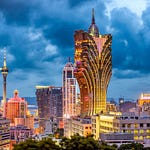Welcome to East West Hurricane! 🌪
We update you on the most essential news from Asia in tech, media, and business—the things you need to know that you probably haven’t heard in Western media.
Follow us on Twitter and Instagram! ⚡️
Lessons from China’s Domestic Tourism 🛫
All over the world, professionals in the travel industry are struggling because of the coronavirus. In China, the tourism industry isn’t doing as poorly as you might expect and right now, Chinese domestic tourism is going through a strong recovery. From all time lows at the beginning of the year, the Chinese domestic tourism industry has emerged out of the global pandemic by doing some innovative things. Livestreaming has been used as an entertainment/commerce channel for most travel companies, who are using livestreams enthusiastically to sell products.

Ctrip, China’s largest online travel agency (OTA), has put on several livestreams hosted by their co-founder James Liang. On each livestream, James Liang really puts himself out there by dressing up in traditional Chinese outfits and selling products related to major domestic tourist destinations. And each livestream has sold millions of dollars worth of products. Airlines, hotels, and destinations are all using livestreams to sell aggressive discounts. For example, China Eastern airlines now has an ‘all you can fly deal,’ which allows you to travel on an unlimited number of domestic flights over a several month time period. You can find even more examples in this presentation from Jing Daily and Dragon Tail Interactive. I hope other countries can take some inspiration from the Chinese travel industry.
A.S.E.A.N. stands for the Association of Southeast Asian Nations, which is an intergovernmental organisation you might think of like the UN of Southeast Asian countries - Singapore, Indonesia, Thailand, Philippines, Malaysia, Vietnam, Brunei, Myanmar, Cambodia, and Laos. All of these countries have suffered from drops in tourism due to the coronavirus. Beginning with an agreement on joint tourism cooperation several months ago, the ASEAN nations are trying to work together in order to encourage more inter-country tourism.

Malaysia and Singapore currently allow cross-border travel for essential services, and Tourism Malaysia is looking to open up a travel bubble with other ASEAN nations. Vietnam has also proposed a travel bubble with their ASEAN neighbors. Unfortunately, new covid spikes keep pushing back these well-intentioned plans. In the short term (and for who knows how long), we’re moving to travel bubbles that will first start opening up at a regional level, such as within ASEAN, within Europe, or between Australia and New Zealand.
Thailand’s Wealthy Tourist Strategy 💸
Next week, Thailand will begin receiving its first foreign tourists, flying into Phuket from Guangzhou, China. Since April, foreign visitors haven’t been allowed into Thailand. The tourism industry makes up 11% of Thailand’s GDP, and is expected to contract dramatically this year. On the flipside, Thailand might have a tourism advantage, since there have been zero cases of local transmission of the coronavirus over the last hundred days. This might make Thailand appear to be a safe, attractive tourism destination.

At the same time, Thailand is looking into a broader mass-scale border opening at the beginning of next year. The Thai government has also discussed the possibility of issuing new special tourist visas to attract more foreigners and new local investment incentives to attract international investors to come to the country. Two days ago, I wrote about the Japanese government creating a new startup visa category for foreign university graduates. Because of the coronavirus, it seems that every Asian country will slowly start rolling out new incentives to attract foreign tourists, investors, and businesses. So if you’re looking to travel, work, or live in Asia in the near future, you may have more options now than ever before.














Share this post